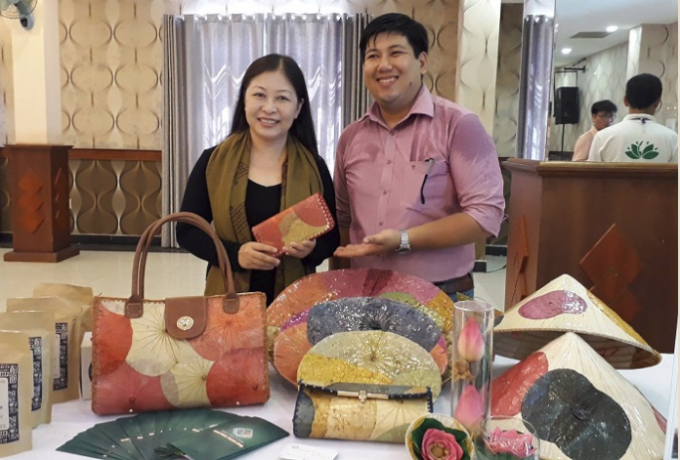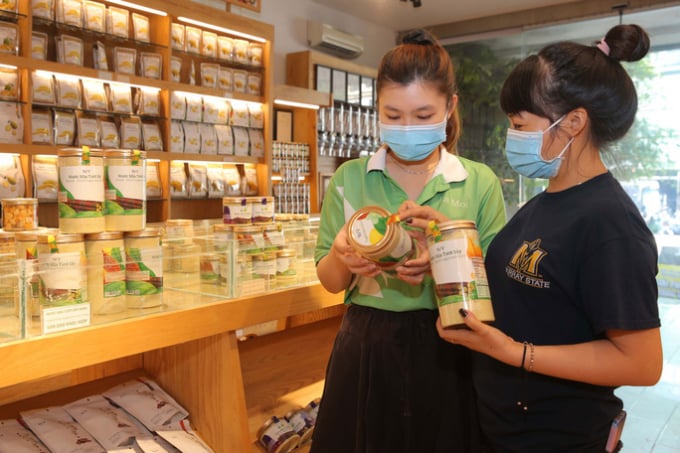June 17, 2025 | 18:35 GMT +7
June 17, 2025 | 18:35 GMT +7
Hotline: 0913.378.918
June 17, 2025 | 18:35 GMT +7
Hotline: 0913.378.918
I still remembered once my niece gave me a colorful pack of fish skins made in China. At that time I asked her "Can they raise catfish for this snack? My niece laughed and said: "Oh, no these are dried skins coated with cheese and quite tasty. The snack is not made from the catfish raised in China but from Vietnam."
Many years ago, the Chinese traders came to Vietnam and collected all catfish by-products produced from processing the catfish fillets with head, tailbone, fins, skins, abdominal fat and even fish blood. And these by-products were sold for very cheap prices. After that, they were brought to China and turned into various delicious snacks that were then re-introduced into Vietnamese market at high prices.

Dried lotus leaves and flowers were used as decorations at CT Ecolotus's coffee and tea shops in HCM city and in France.
Recently as a judge at a start-up contest organized in Dong Thap, "King Mushroom cultivation using dried straw in the Mekong Delta" project has attracted my notice. Pham Thi Phuoc Van, a teacher and a biological engineer from Phuoc Van Family Farm, said she came up with the idea of using straw for growing mushroom because she realized that the Mekong Delta produced up to 50 million tons of dried straw every year. Although the local farmers used the straw for growing mushrooms, composting or as fodder for livestock the amount left was too big. The farmers had no choice to handle it but to burn the straw, causing air pollution.
The reality prompted Phuoc Van to think of growing mushroom on straw. Since April until now she has opened six classes to teach other households in the region to do the same. Van mentioned eight advantages of growing mushroom on straw including high economic value, easy-to -do, easy -to -preserve and creating stable income for growers at VND8 million per month.
I spoke to Van: "You are so good at circular economy: Maybe, this is the first time she has known about the concept of circular economy. Then she asked me softly: "Is this a new farming model?"
I told the young women the story of fish skin snack I have just eaten a week before. The endless paddy fields and lush orchards in the Mekong Delta are considered potential resources for the implementation of a circular economy. From coconut, banana, jackfruit to lotus and rice, each crop is a rich source of agriculture by-products. For example, young green jackfruits can be used an ingredient for plant-based meat manufactured by Vinamit and exported to Europe.
Eight years ago, Vinh Hoan Company embarked on the model of circular economy by extracting collagen and gelatin from fish skins to optimize the use of this by-product. With the establishment of a GMP-WHO certificated factory, the company could produce pharmaceuticals and cosmetics from these extracts and export them around the world. Speaking at the Mekong Connect 2020 Forum, Le Khanh said the company has methodically implemented circular economy model considering it a sustainable approach. Accordingly, 50% of the company's aquaculture farming area were planned for renewable energy and the waste from fish farming was considered an important input source in other circular process.

Ngo Chi Cong, Ecolotux's director and expert Nguyen Phi Van at the opening ceremony of a lotus tea shop in HCM city.
Looking back Vietnam's agriculture, we have VAC integrated farming system (Vườn-garden/orchard, Ao-Pond, Chuồng-Pigsty/poultry shed), a traditional approach to family food production. Apart from this farming model, we also have many other traditional approaches such as utilizing plants, fruits, flowers, leaves, and even young green fruits for food production. It seems that Vietnamese farmers have especially got familiar with circular economy?
Is it right to say that the circular economy is only suitable for agriculture?
No, absolutely not. Today, the circular economy is a trend in many developed economies. The world is now promoting the notion of green economy or sustainable economy in which the circular economy is a trend worldwide, a modern model that is worth to receive methodical and systematic investment.
Particularly, the concept of the circular economy has also been adopted by the Resolution of the XIII National Party Congress. In Section 5, the national development plan in the 2021-2030 period describes "Develop a circular and environmentally friendly economy". This is the first time the concept of circular economy has been mentioned in a Resolution of the National Party Congress.
As an economic model, the circular economy is specifically expressed through the way we treat waste to protect both resources and environment.
I had opportunities to join many coffee meetings and talk business with leaders of many FDI companies as well as technology companies from Europe and North America. They all paid attention to the mutual relationship between the circulation and environmental protection. In a recent meeting, they said that if the Resolution of the XIII National Party Congress considers the circular economy a necessary model, the ministries and agencies must be fully aware of this orientation.
According to environment consultants, Vietnam should focus on developing an important industry that is packaging waste recycling.
Basically it's basically necessary to develop a legal framework and a set of criteria related to the circular economy even when the principles of a circular economy were mentioned in a number of official documents or in several agricultural projects.

Vinamit's young green jackfruits were exported to the US and Europe.
The world has applied the circular economy model for a long time with the preparation of technologies, techniques and human resource and even policies. We can learn from these precious experiences.
Life has been changing quickly and the world economy has been changing from digitalization to standardization and comprehensive integration for sustainable development.
Until now the notion of green economy that is a combination of three elements including economy, society and environment has become an inevitable trend in many countries. In the face of ongoing global warming, severe disasters and depleted natural resources, this is a sustainable approach.
Vietnam is reaching its dream of green economy. The fourth industrial revolution (4.0 revolution) has been now taking place with dizzying speed. We have no time to wait."The grapes are still young and green" is a complaining of the delay, the lack of competitiveness because we are not ready to change and move forward.
The green dream must definitely remove the obsession of "the grapes are still young and green" to lead Vietnam to a brighter future.
Translated by Mai Tham
/2025/06/12/3721-2-202745_83.jpg)
(VAN) TH made an impression at Seoul Food 2025 with its line of natural beverages, paving the way for Vietnamese food products to enter the South Korean market.

(VAN) Soc Trang's success in rice exports stems from a strategy of developing fragrant and specialty rice cultivation areas and standardizing production toward low-emission practices.
/2025/06/11/1311-5-120811_839.jpg)
(VAN) The pig farming industry is facing the challenge of comprehensive restructuring to meet requirements for quality, safety, traceability, and market expansion both domestically and for export.

(VAN) Vietnam considers participating in ALGROALBA in order to expand agricultural production, coordinate the assessment and effective exploitation potential land.
/2025/06/05/5314-1-184727_407.jpg)
(VAN) From seemingly worthless fish scales and skin, enzymes and lactic ferments can transform by-products into peptides, opening a sustainable, effective business direction and elevating Vietnamese seafood.

(VAN) TTC AgriS and IFC signed a strategic partnership to develop a sustainable agricultural value chain, aiming to achieve the Net Zero target by 2035.

(VAN) Seafood by-products are opening a new path, combining green growth and technological innovation to enhance the industry's value.